- Home
- Stephen Baxter
Space m-2 Page 15
Space m-2 Read online
Page 15
It seemed very important to them that they understood how he saw the universe, what motivated him. As for himself, he knew that understanding was going to be the only way humans were ever going to deal with these strangers from the sky.
But it was hard.
Cassiopeia would never have picked out that peninsula’s chance resemblance to Florida. Even if some mapping routine had done it for her, he supposed, it would have meant nothing, save as an example of convergent processes in geology. The Gaijin sought patterns, of course — it was hard to imagine a science that did not include elements of pattern recognition, of correlation and trend analysis — but they were not distracted by them, like humans.
No doubt this was simply a product of differing evolutionary origins. The Gaijin had evolved in the stately stillness of deep space, where there was, in general, time to think things through; humans had evolved in fast-moving, crowded environments where it paid to be able to gaze into the shadows of a tree, a complex visual environment of dapples and stripes, and pick out the tiger fast.
But the end result was that he simply could not communicate to Cassiopeia why it pleased him to pick out an analog of Florida off the shore of some unnamed continent, on a planet light-years from Earth.
Cassiopeia was still waiting for a reply.
“Never mind,” he said. He opaqued the membrane and began his routine for sleep.
Talking to aliens:
It didn’t help that he didn’t really have any idea who, or what, he was talking to.
He had no idea how complex an individual Gaijin was. Was Cassiopeia equivalent to a car, a bacterium, a person, something more?
And the question might have no meaning, of course. Just because he communicated with a discrete entity he called Cassiopeia, it didn’t mean there had to be anything like a corresponding person behind his projection. Maybe he was talking to a limb, or a hand, or a digit of some greater organism — a superbeing, or some looser Internet of minds.
Still, he had found places to start. His first point of contact had been navigation.
Both he and Cassiopeia were finite, discrete creatures embedded in a wider universe. And that universe split into obvious categories — space, stars, worlds, you, me. It had been straightforward to agree on a set of labels for Sol, Earth, and the nearby stars — even if that wasn’t the custom of the Gaijin. They thought of each star as a point on a dynamic four-dimensional map, defined not by a name but by its orientation compared to some local origin of coordinates. So their label for Sol was something like “Get to Alpha Centauri and hang a left for four light-years”… except that Alpha Centauri, the local center of Gaijin operations, was itself defined by an orientation compared to another, more remote origin of coordinates — and so on, recursively back, until you reached the ultimate origin: the starting point, the home world of the Gaijin.
And this recursive web of directions and labeling was, of course, subject to constant change, as the stars slid through the sky, changing their orientations to each other.
It was a system of thinking that was logical, and obviously useful for a species who had evolved to navigate among the stars — a lot more so than the Earthbound human habit of seeking patterns in the random lamps of the sky, patterns called constellations, that shifted because of perspective if you moved more than a couple of light-years from Earth. But it was a system that was far beyond the capacity of any human mind to absorb.
Another point of contact: You. Me. One. Two. In this universe, it seemed, it was impossible not to learn to count.
Malenfant’s math extended — shakily — as far as differential calculus, the basic tool mathematicians used to model reality. It did appear that Cassiopeia thought of the world in similar terms. Of course, Cassiopeia’s mathematical models were smarter than any human’s. The key to such modeling was to pick out the right abstractions from a complex background: close enough to reality to give meaningful answers, not so detailed they overwhelmed the calculations. For the Gaijin, the boundaries of abstraction and simplification were much farther back than any human’s, her models much richer.
And there were more fundamental differences. Cassiopeia seemed much smarter at solving the equations than Malenfant, or any human. He managed to set out for her the equations of fluid mechanics, one of his specialties at college, and she seemed to understand them qualitatively: She could immediately see how these equations, which in themselves merely described how scraps of flowing water interacted with each other, implied phenomena like turbulence and laminar flow, implications it had taken humans years — using sophisticated mathematical and computational tools — to tease out.
Could Cassiopeia look at the equations of relativity and see an implied universe of stars and planets and black holes? Could she look at the equations of quantum mechanics and see the intricate chemistry of living things?
Of course, that increased smartness must lead to a qualitative jump in understanding. A chimp didn’t think about things more simply than Malenfant did; it couldn’t grasp some of his concepts at all. There were clearly areas where Cassiopeia was simply working above Malenfant’s wretched head.
Cassiopeia had spent time trying to teach him about a phenomenon just a little beyond his own horizon — as chaos theory might have been to an engineer of, say, the 1950s. It was something to do with the emergence of complexity. The Gaijin seemed able to see how complexity, even life, naturally emerged from the simplest of beginnings: not fundamental physical laws, but something even deeper than that — as far as he could make out, the essential mathematical logic that underlay all things. Human scientists had a glimmering of this. His own DNA somehow contained, in its few billion bases, enough information to generate a brain of three trillion connections…
But for the Gaijin this principle went farther. It was like being given a table of prime numbers and being able to deduce atoms and stars and people as a necessary consequence of the existence of the primes. And since prime numbers, of course, existed everywhere, it followed there was life and people, humans and Gaijin, everywhere there could be.
Life sprouting everywhere, like weeds in the cracks of a pavement. It was a remarkable, chilling thought.
“Take me to your home,” he’d said one day.
Cassiopeia’s choice of a human label for her remote home was “Zero-zero-zero-zero,” the great sky map’s origin of coordinates.
I AM THE SUCCESSOR OF A REPLICANT CHAIN THAT EMERGED THERE, she’d said. She was descended from emigrants? Not exactly, because she’d continued. I RETAIN RECORDS OF ZERO-ZERO-ZERO-ZERO. Memories? Did each Gaijin come to awareness with copies of the memories of those who bore her — or constructed her? Were they, then, her memories, or a mere copy? IT IS POSSIBLE TO TRANSLATE TO ZERO-ZERO-ZERO-ZERO. THERE IS NO PURPOSE.
“I’d like to see it.”
THERE ARE RECORDS THAT—
“Your records only show me your world through your eyes. If we’re ever going to understand each other, you have to let me see for myself.”
There was a long hesitation after that.
FINALLY, she’d said then.
“What?”
THERE ARE MANY PLACES TO SEE. MANY WORLDS. BEFORE ZERO-ZERO-ZERO-ZERO.
“I understand. One day…”
ONE DAY.
But not today, Malenfant thought, as he opened his eyes to the light of a foreign Sun. Not today. Today, we are both far from home.
Cassiopeia provided him with an environment suit — a loosely cut coverall of what felt like a high-grade plastic. It had no zippers; he learned to seal it up by passing his thumb along the open seams. He lifted a hoodlike helmet over his head. There was a clear faceplate, a slightly opaque filter near his mouth.
There was no independent air supply, just one layer of fabric. The whole thing jarred with Malenfant’s intuition of the protection he would need to walk on an alien world. But Cassiopeia assured him it would be enough. And besides, the only alternative was his battered shuttle EMU suit, still with hi
m, crammed into a corner of the lander, his only possession, long past its operational lifetime.
“Open the door. Please.”
The lander door dilated away. The world beyond was green and black.
The lander’s cabin floor was almost flush with the ground, and he stepped out, pace by pace, testing his suit. Gravity was a little more than Earth normal, comfortingly familiar, and the air pressure just a little higher than Earth’s sea level.
First impressions:
He was alone in an open forest, like park land. There were objects that were recognizably trees, about the size of Earth trees, and what appeared to be grass under his feet. Above his head a Sun sailed through a sky littered with high wispy cirrus clouds.
He closed his eyes. He could hear the soft hiss of wind over the grass, and a distant piping, for all the world like a bird’s song, and when he breathed in he filled his lungs with cool, crisp air.
It might have been Earth.
But when he opened his eyes, he saw a sky that was a lurid yellow-green. It was like a haze of industrial smog. The vegetation was a very deep green, almost black.
And he could smell chlorine.
His filter removed all but a trace of the chlorine compounds that polluted the atmosphere — including phosgene, toxic stuff humans had once used to slaughter each other. If not for his suit, this friendly looking world would soon kill him.
Chlorine: That was the big difference here. Most of Earth’s chlorine was locked up in the oceans, in the form of a stable chloride ion. This world seemed to have started out as roughly Earthlike. But something, one small detail, had been different: Here, something had pumped all that chlorine into the air.
He walked forward, over grass that crushed softly under his feet.
He reached a narrow valley, a rushing brook. There was a stand of trees nearby. The bed of the little stream was just a soft muddy clay, no sign of any rocks. The water was colorless, clear. He knelt down, stiffly, and dipped his fingers into the water. It was cold, its pressure gentle against his gloved hands.
WARNING. SOLUTION OF HYDROGEN CHLORIDE. HYPOCHLORIC ACID.
He snatched back his fingers. Like a swimming pool, he thought: Chlorine plus water gave a solution of acid and bleach. The weathering of any rocks here must be ferocious; no wonder only clays survived.
He straightened up to inspect a tree. He touched branches, leaves, a trunk, even a blossom. But to his gloved fingers the leaves felt slippery, soapy.
From a hollow in the tree trunk, at about his eye level, a small face peered out: the size and shape of a mouse’s, perhaps, but with a central mouth, three eyes arranged symmetrically around it. The mouth opened, showing flat grinding surfaces, and the little creature hissed, emitting a cloud of greenish gas. Then it ducked back into the hole, out of his sight.
The trunk didn’t feel like wood. He reached up and broke off a twig; it snapped reluctantly. The interior was springy, fibrous. The leaves, the tree trunk, were made of some kind of natural plastic — perhaps a form of polyvinyl chloride, PVC. If he could smell the blossom, it would surely stink like toxic waste.
It was like a grotesque model of a tree, a thing of plastic and industrial waste. And yet the breeze ruffled it convincingly, and sunlight dappled the green-black grass beneath.
In his ear, Cassiopeia, from orbit, began to lecture him about biochemistry. THE LIVING THINGS HERE ARE CONSTRUCTED OF CELLS — ANALOGOUS TO LIVING THINGS ON EARTH, TO YOU. THEIR METABOLISMS ARE NOT TOLERANT OF THE CHLORINE. BUT THEY HAVE EVOLVED SHIELDING AT THE CELLULAR LEVEL…
He interrupted. “There are trees here,” he said. “Grass. Flowers. Animals.” You see biochemistry. I see a flower, he thought.
There was a long silence.
It was the Gaijin way of seeing reality: from the equations of quantum mechanics, working up to a world. But that wasn’t the way Malenfant thought. Humans, it seemed, were better at broad comprehension than the Gaijin, quicker at abstracting simplicity from complexity. This object before Malenfant wasn’t a tree, because trees only grew on Earth. But it helped Malenfant to think in those terms, to seek patterns and map them back to what he knew.
The Gaijin, slowly, were learning to ape his thinking.
YES, came the reply. THERE ARE TREES.
“Cassiopeia. Why did you bring me here, to this chlorine-drenched waste dump?”
TO GATHER MORE DATA, MALENFANT.
Malenfant scowled at the sky.
The Gaijin seemed to be trying to educate him, for purposes of their own. They had shown him worlds, all of them very different, all of them bearing life. All of them scarred, in some way.
The Gaijin saw the universe as some immense computer program, he was coming to believe: an algorithm for generating life and, presumably, mind wherever and whenever it could.
The trouble was, the program had bugs.
He grunted. “All right. Where? How?”
WALK A KILOMETER, TOWARD THE SUN.
Muttering complaints, sipping cool water from a pipe inside his hood to dispel the swimming-pool taste of chlorine, he stalked on.
And, long before the kilometer was covered, he found people.
There was a crowd of them, a hundred or more, gathered around what appeared to be a pit in the ground. They moved in a kind of dance, chains of people weaving in and out to a murmur of noise, soft as a wind blowing.
Most of the dancers appeared to be somewhere near his own height. Few were taller, but several were a lot smaller — children? The elderly, withered by age?
Not humans, of course. But people, yes.
He glanced around, seeking cover. But Cassiopeia reassured him.
THERE IS A PERCEPTUAL DYSFUNCTION, MALENFANT. He translated to himself: They can’t see you.
“Why not?… Oh. Captain Cook.”
COMMUNICATION DYSFUNCTION.
There was a story — probably apocryphal — that on one of the islands visited by Cook, the natives had been unable even to see his great exploratory ships. They had never encountered such large floating artifacts before. It was only when Cook’s crew put out in landing boats that the natives were able to comprehend.
Thus, Malenfant was simply too strange an element in the dancers’ world for them to perceive.
“Never mind. Humans have limits like that too.”
Feeling a little bolder, he stepped forward, looking more closely.
He picked out one of the dancers. She — he decided the sex arbitrarily — stood upright. She had a clearly defined torso and head, sets of upper and lower limbs. But she had three of everything — three arms, three legs — and her limbs articulated back and forth in a complex, graceful way he found unnerving. She didn’t walk, exactly, shifting her weight from foot to stomping foot as he did. Rather, she spun around, whirling, letting one foot after another press lightly on the ground. It was high-speed and difficult to follow, like trying to figure out how a horse ran; but after he’d watched for a few seconds it seemed easy and natural.
Her head, positioned up at the top of her trunk, was about where his was. He saw three eyes, what appeared to be a mouth, other orifices that might be ears, nostrils. She seemed to be naked save for a belt slung over one of her three shoulders, like a sash. He could see tools dangling there: a lump of quartzlike rock that could have been a handheld hammer, what looked like a bow of the natural-plastic wood. Stone Age technology, he thought.
…Of course Stone Age. Most metals would just corrode here. Gold would survive, but try making a workable ax out of that. Even fire would be problematic; all that chlorine would inhibit flame. There could be no ceramics, for instance.
Because of an accident of biochemistry these people were stuck forever in the Stone Age. And since most rock would be corroded away, there wasn’t even much of that.
Maybe these people had a rich culture, an oral tradition, dance. But that was all they could ever have. He watched the woman-thing whirl, with admiration, with pity.
WHAT IS THE PURPOSE OF THE
PATTERNLESS SOUNDS THEY MAKE?
“Patternless…” Malenfant smiled. “Perceptual incongruence, Cassiopeia. Transform your data. Look at the frequency content, the ratios between the tones… We’ve discussed this before.” The Gaijin analyzed sound digitally, not with analog microphonelike systems like the human ear. And so the patterns they judged as agreeable — valuable, anyhow — were complex numeric constructs, not the harmonies that pleased human ears.
A long silence. IT IS A FORM OF MUSIC, Cassiopeia stated.
“Yes. They’re singing, Cassiopeia. Singing, that’s all.”
Now the dancing reached a climax, the howl of voices more intense. One of the dancers spun out of the group, whirling in a decaying orbit toward that pit around which they all gyrated.
Then, with a fast shimmying movement, she got to her belly and slid gracefully into the hole.
The dancers continued, for thirty seconds, a minute, two, three, four. Malenfant just watched.
At last the potholer returned. Malenfant saw that trio of upper arms come flopping over the rim of the pit. She seemed to be in trouble. Dancers broke away, four or five of them hurrying to haul their partner out of the hole.
She lay on her back, shuddering, obviously distressed. But she held up something to the light. It was long, dark brown, pitted, and heavily corroded. It was a bone — bigger than any human bone, half Malenfant’s height, and with a strange protrusion at one end — but unmistakably a bone even so.
“Cassiopeia — what’s hurting her?”
CHLORINE POISONING. CHLORINE IS A HEAVY GAS. IT POOLS IN LOW PLACES.
“Like that hole in the ground.”
YES.
“And so, when she went down there to retrieve that bone…”
The dancer had been asphyxiated. She was tolerant of chlorine, but couldn’t breathe it.
The potholer passed the bone on to another. Malenfant saw that where her long, flipperlike hand had wrapped around the bone, it had been corroded. And when the dancer took hold of it, the bone surface sizzled and smoked to her touch. Carbonate, burning in the air.

 The Martian in the Wood
The Martian in the Wood THE H-BOMB GIRL
THE H-BOMB GIRL World Engine
World Engine Titan n-2
Titan n-2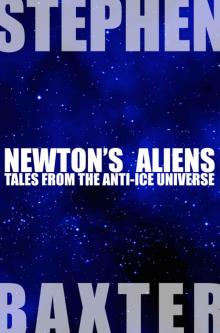 Newton's Aliens: Tales From the Anti-Ice Universe
Newton's Aliens: Tales From the Anti-Ice Universe Exultant
Exultant Manifold: Origin
Manifold: Origin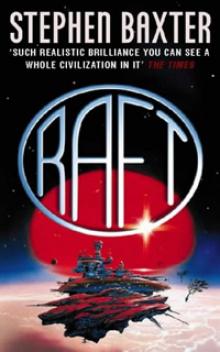 Raft xs-1
Raft xs-1 Bronze Summer n-2
Bronze Summer n-2 Transcendent
Transcendent Stone Spring
Stone Spring Coalescent
Coalescent The Medusa Chronicles
The Medusa Chronicles Origin m-3
Origin m-3 Silverhair tm-1
Silverhair tm-1 Ultima
Ultima Voyage n-1
Voyage n-1 Xeelee: Endurance
Xeelee: Endurance Space m-2
Space m-2 Ring xs-4
Ring xs-4 Raft
Raft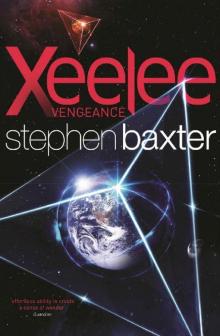 Xeelee: Vengeance
Xeelee: Vengeance Iron Winter n-3
Iron Winter n-3 Vacuum Diagrams
Vacuum Diagrams Longtusk tm-2
Longtusk tm-2 Proxima
Proxima Evolution
Evolution Titan
Titan Last and First Contacts (Imaginings)
Last and First Contacts (Imaginings) Emperor
Emperor The Massacre of Mankind
The Massacre of Mankind Starfall
Starfall Doctor Who - The Wheel of Ice
Doctor Who - The Wheel of Ice Longtusk
Longtusk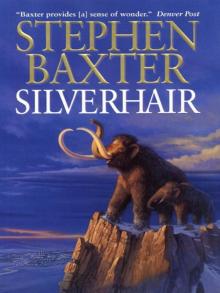 Silverhair
Silverhair Conqueror tt-2
Conqueror tt-2 Flood
Flood Flood f-1
Flood f-1 Emperor tt-1
Emperor tt-1 Moonseed
Moonseed Conqueror
Conqueror Timelike Infinity xs-2
Timelike Infinity xs-2 The Ghost Pit
The Ghost Pit Xeelee: An Omnibus: Raft, Timelike Infinity, Flux, Ring
Xeelee: An Omnibus: Raft, Timelike Infinity, Flux, Ring Weaver tt-4
Weaver tt-4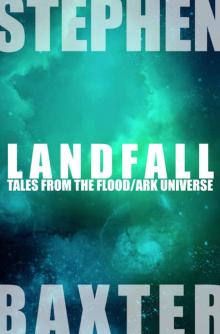 Landfall: Tales From the Flood/Ark Universe
Landfall: Tales From the Flood/Ark Universe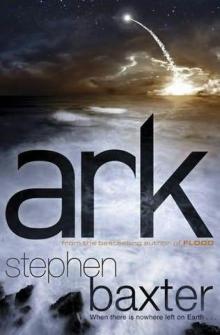 Ark
Ark Emperor: Time’s Tapestry Book One
Emperor: Time’s Tapestry Book One Space
Space Icebones
Icebones Manifold: Space
Manifold: Space Navigator
Navigator Obelisk
Obelisk The Time Ships
The Time Ships Bronze Summer
Bronze Summer Resplendent
Resplendent Moonseed n-3
Moonseed n-3 Flux xs-3
Flux xs-3 Transcendent dc-3
Transcendent dc-3 Icebones tm-3
Icebones tm-3 Phase Space
Phase Space Anti-Ice
Anti-Ice Weaver
Weaver Voyage
Voyage Time m-1
Time m-1 Timelike Infinity
Timelike Infinity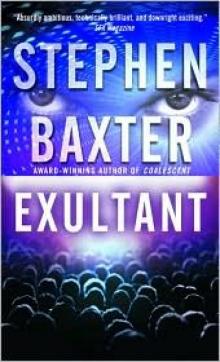 Exultant dc-2
Exultant dc-2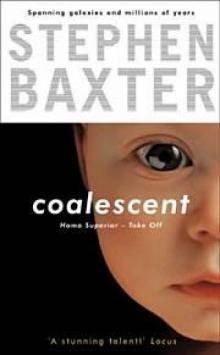 Coalescent dc-1
Coalescent dc-1 Navigator tt-3
Navigator tt-3